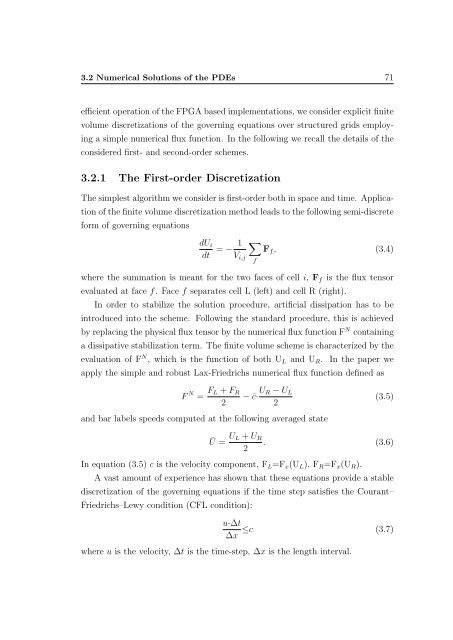PPKE ITK PhD and MPhil Thesis Classes
PPKE ITK PhD and MPhil Thesis Classes
PPKE ITK PhD and MPhil Thesis Classes
Create successful ePaper yourself
Turn your PDF publications into a flip-book with our unique Google optimized e-Paper software.
3.2 Numerical Solutions of the PDEs 71<br />
efficient operation of the FPGA based implementations, we consider explicit finite<br />
volume discretizations of the governing equations over structured grids employing<br />
a simple numerical flux function. In the following we recall the details of the<br />
considered first- <strong>and</strong> second-order schemes.<br />
3.2.1 The First-order Discretization<br />
The simplest algorithm we consider is first-order both in space <strong>and</strong> time. Application<br />
of the finite volume discretization method leads to the following semi-discrete<br />
form of governing equations<br />
dU i<br />
dt = − 1 ∑<br />
F f , (3.4)<br />
V i,j<br />
where the summation is meant for the two faces of cell i, F f is the flux tensor<br />
evaluated at face f. Face f separates cell L (left) <strong>and</strong> cell R (right).<br />
In order to stabilize the solution procedure, artificial dissipation has to be<br />
introduced into the scheme. Following the st<strong>and</strong>ard procedure, this is achieved<br />
by replacing the physical flux tensor by the numerical flux function F N containing<br />
a dissipative stabilization term. The finite volume scheme is characterized by the<br />
evaluation of F N , which is the function of both U L <strong>and</strong> U R . In the paper we<br />
apply the simple <strong>and</strong> robust Lax-Friedrichs numerical flux function defined as<br />
f<br />
F N = F L + F R<br />
2<br />
− ¯c·UR − U L<br />
2<br />
<strong>and</strong> bar labels speeds computed at the following averaged state<br />
(3.5)<br />
Ū = U L + U R<br />
. (3.6)<br />
2<br />
In equation (3.5) c is the velocity component, F L =F x (U L ), F R =F x (U R ).<br />
A vast amount of experience has shown that these equations provide a stable<br />
discretization of the governing equations if the time step satisfies the Courant–<br />
Friedrichs–Lewy condition (CFL condition):<br />
u·∆t<br />
≤c (3.7)<br />
∆x<br />
where u is the velocity, ∆t is the time-step, ∆x is the length interval.






![optika tervezés [Kompatibilitási mód] - Ez itt...](https://img.yumpu.com/45881475/1/190x146/optika-tervezacs-kompatibilitasi-mad-ez-itt.jpg?quality=85)









